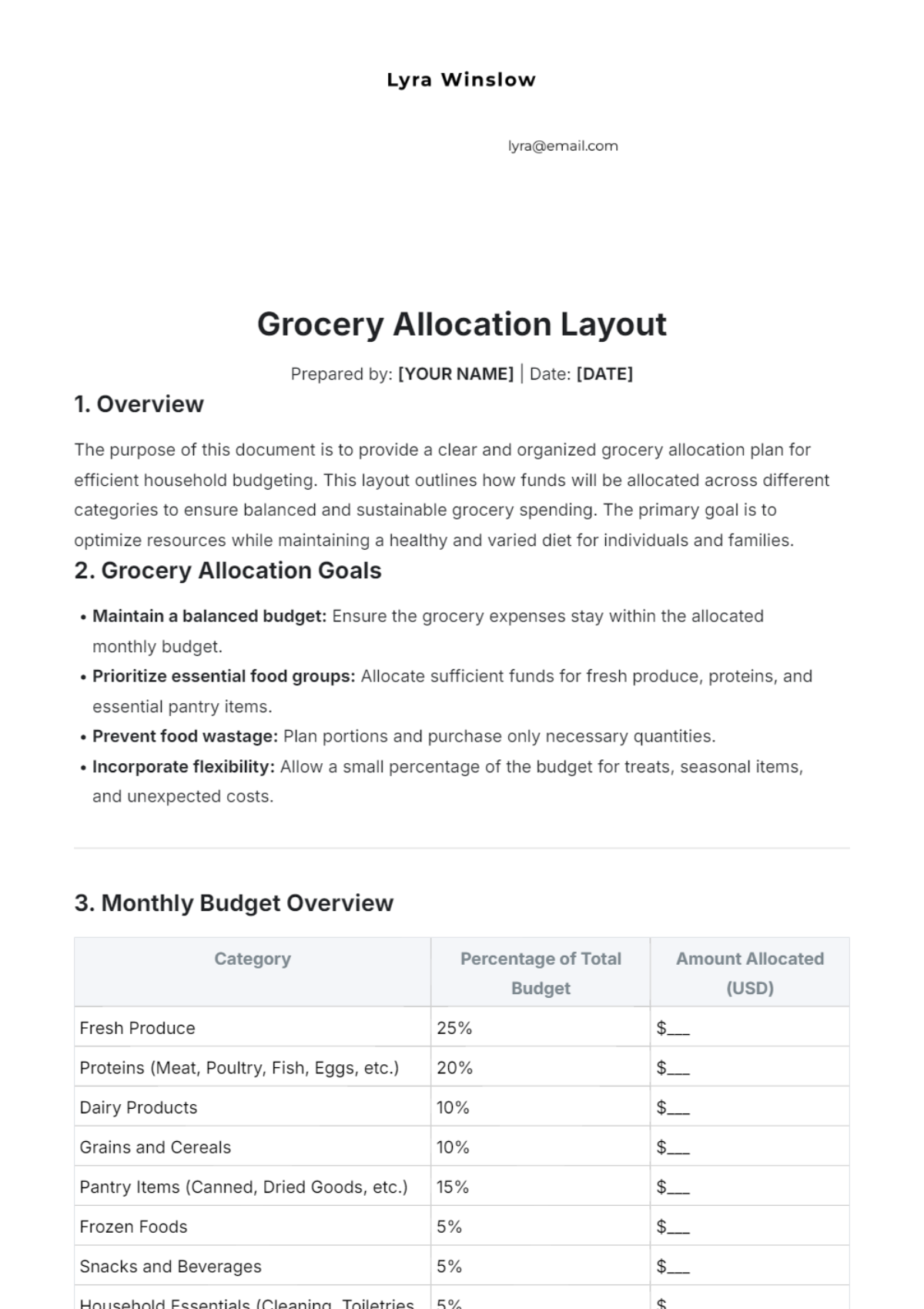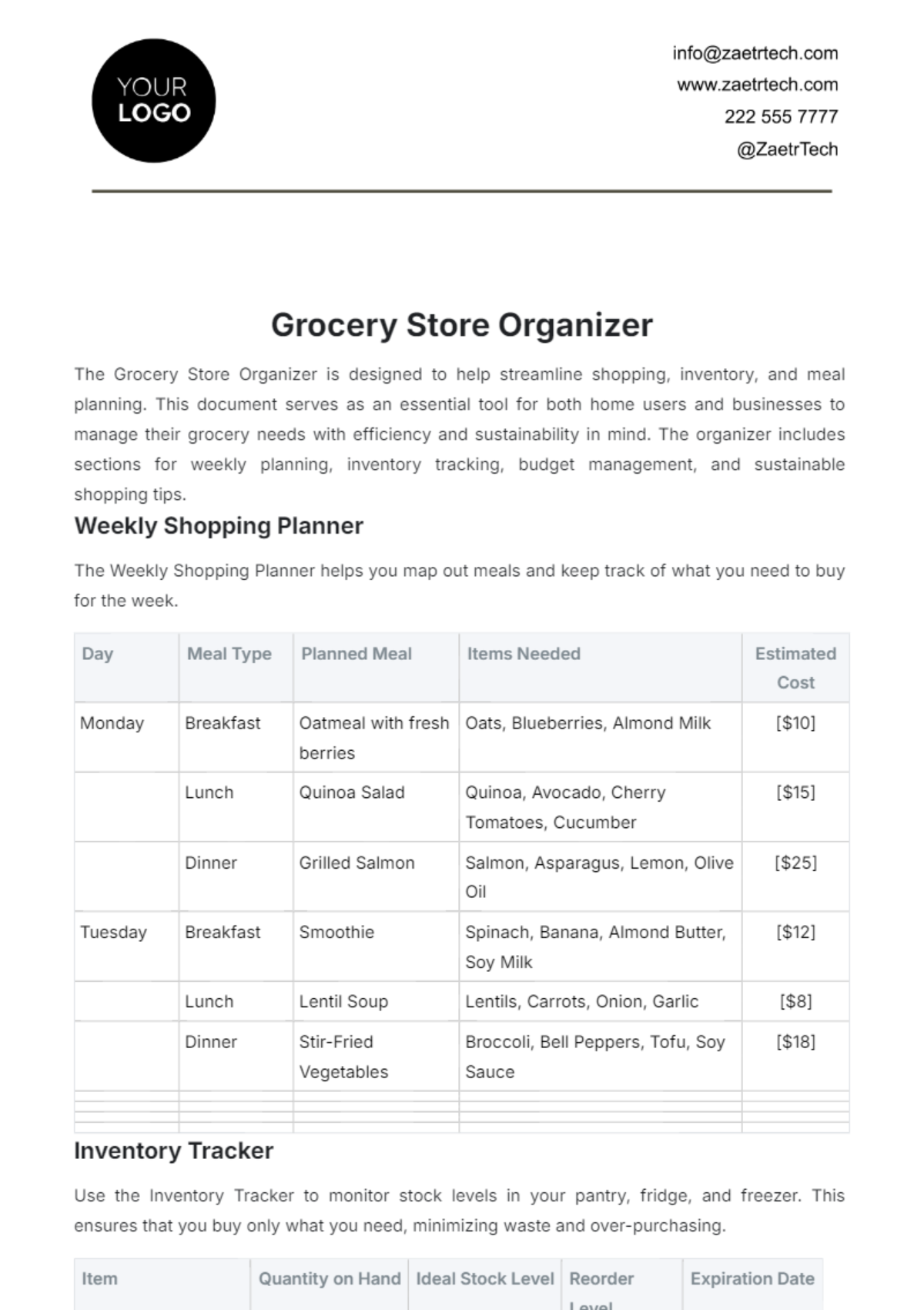Grocery Store Returns SOP
I. Introduction
A. Purpose
The purpose of this Grocery Store Returns SOP is to establish clear procedures and guidelines for handling returns at [Your Company Name]. This ensures a consistent and efficient process for both staff and customers. By following these guidelines, we aim to enhance customer satisfaction by providing a smooth and hassle-free returns experience.
B. Scope
This SOP applies to all departments within the store that handle returns, including customer service, cashier, and inventory management. All employees involved in the returns process must adhere to these guidelines to ensure compliance and efficiency.
II. Returns Eligibility
The following table outlines the eligibility criteria for returns at [Your Company Name]:
No. | Criteria | Description |
|---|---|---|
1 | Receipt Requirement | A valid receipt must be presented for a return to be accepted. |
2 | Time Frame | Returns must be made within 30 days of purchase. |
3 | Condition of Item | Items must be in original condition, unused, and unopened. |
4 | Exclusions | Certain items like perishables and clearance items are not eligible for return. |
5 | Proof of Identification | Customers may need to provide proof of identification for returns over a certain amount. |
A. Receipt Requirement
Proof of Purchase: A valid receipt serves as proof of purchase and is necessary to process any return. This ensures that the item was bought from our store and falls within our return policy.
Verification Process: Cashiers and customer service representatives must verify the receipt against the item being returned. This helps prevent fraudulent returns and maintains inventory accuracy.
B. Time Frame
30-Day Limit: Returns must be made within 30 days from the date of purchase. This time frame ensures that items are returned in a condition suitable for resale.
Exceptions: Certain promotions or sales may extend the return window, which will be clearly communicated to customers at the time of purchase.
C. Condition of Item
Original Condition: Items must be returned in their original condition, which means unused, unopened, and with all original packaging and tags intact. This ensures that returned items can be resold.
Inspection: Staff must inspect returned items to ensure they meet these conditions. Items not meeting the criteria should be refused and explained to the customer.
D. Exclusions
Non-Returnable Items: Certain items such as perishables, clearance items, and opened personal care products are excluded from our return policy. This is due to hygiene and resale issues.
Communication: Customers should be informed about these exclusions at the time of purchase to avoid misunderstandings.
E. Proof of Identification
Verification for High-Value Returns: For returns over a certain amount, customers may need to provide proof of identification. This helps prevent fraudulent activities and protects both the store and customers.
Data Privacy: Any personal information collected will be handled in accordance with our privacy policy to ensure customer data is protected.
III. Returns Process
The following table provides an overview of the steps involved in the returns process at [Your Company Name]:
No. | Step | Description |
|---|---|---|
1 | Customer Inquiry | Customer approaches with a return inquiry. |
2 | Receipt Verification | Staff verifies the receipt against the return policy. |
3 | Item Inspection | Staff inspects the item to ensure it meets return conditions. |
4 | Return Approval | Staff approves the return if all conditions are met. |
5 | Refund/Exchange | Customer is provided with a refund or exchange. |
A. Customer Inquiry
Initial Contact: Customers should be greeted and asked about the reason for their return. This initial interaction sets the tone for a positive customer experience.
Clarification: Staff should clarify the return policy and any conditions that apply, ensuring the customer understands the process.
B. Receipt Verification
Receipt Check: The receipt must be checked to verify the date of purchase and item details. This step ensures that the return is eligible.
Policy Adherence: Staff should confirm that the return falls within the 30-day return period and meets other eligibility criteria.
C. Item Inspection
Condition Check: The item should be inspected for its condition, ensuring it is unused, unopened, and in original packaging. This step prevents resale issues.
Exclusion Verification: Staff should check if the item is on the non-returnable list. If it is, the customer should be informed politely about the exclusion.
D. Return Approval
Approval Process: If all conditions are met, the return should be approved. This includes completing any necessary documentation or system updates.
Communication: The customer should be informed that their return has been approved and advised on the next steps for their refund or exchange.
E. Refund/Exchange
Processing Refunds: Refunds should be processed according to the original method of payment. This includes crediting credit/debit cards or providing cash refunds for cash purchases.
Offering Exchanges: If the customer opts for an exchange, staff should assist them in selecting a replacement item and processing the exchange efficiently.
IV. Refund Methods
The following table outlines the different refund methods available at [Your Company Name]:
No. | Method | Description |
|---|---|---|
1 | Cash Refund | Refunds are issued in cash for purchases made with cash. |
2 | Credit/Debit Card | Refunds are credited back to the original credit/debit card. |
3 | Store Credit | Refunds can be issued as store credit for future purchases. |
4 | Gift Card | Refunds can be provided in the form of a gift card. |
A. Cash Refund
Cash Transactions: For purchases made with cash, refunds will be issued in cash. This ensures immediate resolution for the customer.
Documentation: Staff must document the cash refund accurately, ensuring that the transaction is recorded in the system for inventory and financial tracking.
B. Credit/Debit Card
Card Refunds: Refunds for purchases made with a credit or debit card will be credited back to the same card. This process ensures security and traceability of the refund.
Processing Time: Customers should be informed that it may take a few business days for the refund to appear on their card statement.
C. Store Credit
Future Purchases: Store credit can be issued to customers who prefer to use their refund for future purchases. This option encourages continued patronage.
Issuance Process: Store credit should be issued in the form of a store credit voucher or account credit, and documented in the system.
D. Gift Card
Alternative Option: Gift cards are a convenient alternative for refunds, especially for customers who may not have the original payment method available.
Value Tracking: The value of the gift card must be accurately tracked and recorded in the system to ensure proper financial management.
V. Handling Defective Items
The following table outlines the steps involved in handling defective items returned to [Your Company Name]:
No. | Step | Description |
|---|---|---|
1 | Initial Assessment | Staff assesses the defect reported by the customer. |
2 | Verification | Staff verifies the defect against product specifications. |
3 | Return Approval | If verified, the return is approved. |
4 | Refund/Exchange | Customer is provided with a refund or exchange. |
5 | Defective Item Handling | Defective item is logged and processed for disposal or return to supplier. |
A. Initial Assessment
Customer Interaction: Staff should listen to the customer's report of the defect and perform an initial assessment to understand the issue. This interaction helps in determining the next steps.
Visual Inspection: A visual inspection of the item should be conducted to identify any obvious defects or damages. This step helps in quickly validating the customer's claim.
B. Verification
Product Specifications: The defect should be verified against the product's specifications and warranty terms. This ensures that the defect is legitimate and not a result of misuse.
Further Inspection: If necessary, a more detailed inspection should be performed to confirm the defect. This may involve consulting with a supervisor or specialist.
C. Return Approval
Approval Criteria: If the defect is verified, the return should be approved based on the store's return policy and warranty terms. This step ensures compliance with store policies.
Documentation: The approval should be documented in the system, including details of the defect and any actions taken. This helps in tracking defective items and ensuring accurate records.
D. Refund/Exchange
Processing Refunds: Refunds should be processed according to the customer's preference and the store's policy. This may involve issuing a cash refund, store credit, or gift card.
Offering Exchanges: If the customer opts for an exchange, staff should assist them in selecting a replacement item and processing the exchange efficiently.
E. Defective Item Handling
Logging Defective Items: Defective items should be logged in the system with details of the defect and any actions taken. This helps in tracking inventory and managing defective items.
Disposal or Return: Defective items should be processed for disposal or returned to the supplier, as appropriate. This step ensures that defective items do not remain in inventory.
VI. Customer Communication
Effective communication with customers is crucial in the returns process. The following table outlines the key communication steps:
No. | Step | Description |
|---|---|---|
1 | Greeting | Staff should greet customers warmly and inquire about their return. |
2 | Explanation | Staff should explain the returns policy clearly. |
3 | Updates | Customers should be kept informed throughout the process. |
4 | Resolution | Staff should ensure that the customer is satisfied with the resolution. |
A. Greeting
Warm Welcome: Customers should be greeted warmly and professionally. This sets a positive tone for the interaction and makes customers feel valued.
Inquiry: Staff should inquire about the reason for the return and listen attentively to the customer's explanation. This helps in understanding the customer's needs and concerns.
B. Explanation
Clear Communication: Staff should explain the returns policy clearly, including any conditions and eligibility criteria. This ensures that the customer is fully informed.
Answering Questions: Staff should be prepared to answer any questions the customer may have about the returns process. This helps in addressing any concerns and building trust.
C. Updates
Process Updates: Customers should be kept informed throughout the returns process, including any inspections or approvals needed. This helps in managing customer expectations.
Timely Information: Staff should provide timely updates, ensuring that customers are not left waiting without information. This enhances the customer experience.
D. Resolution
Ensuring Satisfaction: Staff should ensure that the customer is satisfied with the resolution, whether it is a refund, exchange, or other outcome. This helps in maintaining customer loyalty.
Feedback: Staff should seek feedback from the customer about their experience and use this feedback to improve the returns process. This helps in identifying areas for improvement.
VII. Documentation and Record Keeping
The following table outlines the documentation and record-keeping requirements for returns at [Your Company Name]:
No. | Requirement | Description |
|---|---|---|
1 | Receipt Copies | Copies of receipts for all returns should be kept. |
2 | Return Logs | All returns should be logged in the system. |
3 | Defective Item Reports | Reports on defective items should be maintained. |
4 | Customer Feedback | Feedback from customers should be recorded and reviewed. |
A. Receipt Copies
Keeping Copies: Copies of receipts for all returns should be kept and filed systematically. This ensures that there is a record of all transactions.
Audit Trail: Maintaining receipt copies provides an audit trail for tracking returns and verifying transactions. This helps in ensuring accuracy and accountability.
B. Return Logs
Logging Returns: All returns should be logged in the system with details of the transaction, including the reason for return and the resolution provided. This helps in tracking inventory and managing returns.
Review and Analysis: Return logs should be reviewed regularly to identify trends and areas for improvement. This helps in enhancing the returns process and addressing any issues.
C. Defective Item Reports
Reporting Defects: Reports on defective items should be maintained, including details of the defect and any actions taken. This helps in tracking defective items and managing inventory.
Supplier Coordination: Defective item reports can be used to coordinate with suppliers for returns or replacements. This helps in managing supplier relationships and ensuring product quality.
D. Customer Feedback
Recording Feedback: Feedback from customers should be recorded and reviewed regularly. This helps in identifying areas for improvement and enhancing the customer experience.
Action Plans: Based on customer feedback, action plans should be developed to address any issues and improve the returns process. This helps in ensuring continuous improvement.
VIII. Training and Development
The following table outlines the training and development requirements for staff involved in the returns process at [Your Company Name]:
No. | Training | Description |
|---|---|---|
1 | Returns Policy | Training on the store's returns policy and procedures. |
2 | Customer Service | Training on customer service skills and effective communication. |
3 | Defective Item Handling | Training on identifying and handling defective items. |
4 | System Updates | Training on updates to the returns management system. |
A. Returns Policy
Policy Training: Staff should receive training on the store's returns policy and procedures. This ensures that they understand the policy and can apply it correctly.
Regular Updates: Regular updates should be provided to ensure that staff are aware of any changes to the policy. This helps in maintaining compliance and consistency.
B. Customer Service
Communication Skills: Training on customer service skills, including effective communication, is essential. This helps in ensuring that staff can handle returns professionally and courteously.
Conflict Resolution: Training on conflict resolution techniques can help staff manage difficult situations and ensure a positive customer experience.
C. Defective Item Handling
Identifying Defects: Staff should be trained on how to identify and handle defective items. This ensures that defects are accurately identified and managed.
Handling Procedures: Training should cover the procedures for logging and processing defective items, including coordination with suppliers. This helps in maintaining inventory accuracy.
D. System Updates
System Training: Staff should receive training on any updates to the returns management system. This ensures that they can use the system effectively and efficiently.
Continuous Learning: Ongoing training and development should be provided to ensure that staff are up-to-date with the latest practices and technologies. This helps in enhancing the returns process.
IX. Review and Update
A. Review
This Grocery Store Returns SOP will be reviewed annually to ensure that it remains up-to-date and relevant. The review process will involve assessing the effectiveness of the current procedures and identifying any areas for improvement. Feedback from staff and customers will be considered during the review process. This helps ensure that the SOP addresses any issues and meets the needs of all stakeholders. Regular reviews help maintain the efficiency and accuracy of the returns process.
B. Update
Based on the review, any necessary updates to the SOP will be made to ensure the procedures remain effective and compliant with changes in regulations or store policies. All staff involved in the returns process will be informed of any updates to ensure proper implementation. Clear communication of updates is essential for maintaining consistency in the returns process. Training sessions will be conducted if significant changes are made to the SOP. Continual updates help the store adapt to new challenges and improve customer satisfaction.
























